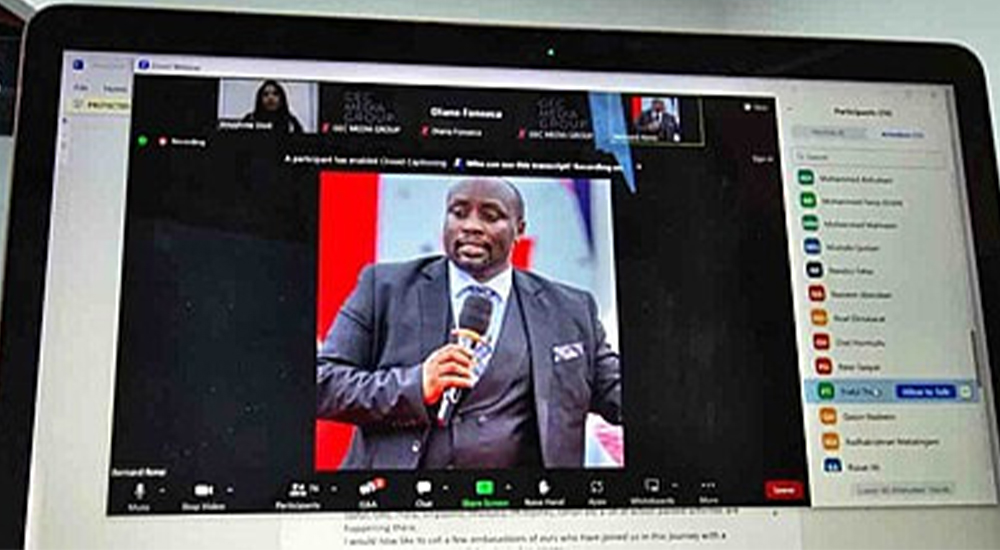LogMeIn commissioned Forrester Consulting to evaluate the current state and future of remote work. To explore this topic, Forrester conducted two online surveys with decision-makers at global organisations with between 10 and 2,500 employees: one survey with 582 remote-work decision-makers and one with 427 non-HR employees.
While there is still much work to be done in creating effective remote-work programmes, there is an incredible opportunity for organisations to create competitive differentiators with flexible work.
While many employees will return to their previous in-office work settings post-pandemic, a rapid movement toward flexible work has begun, and it is not going away after the pandemic. The survey found that 26% of the workforce plans to shift from pure in-office work to a remote or hybrid work style within the next two years.
Nearly three-quarters of workers said that the pandemic made them want to work more remotely in the future, and 62% of employees said they are happier when working remotely.
There is a disconnect in trust between HR and employees. While 56% of employees said they are more productive when working remotely and 61% said they can get more done in an 8-hour workday, only 5% of remote-work decision-makers said they think remote workers are more productive, and 70% said in-office workers are more trustworthy. There is a significant gap in trust.
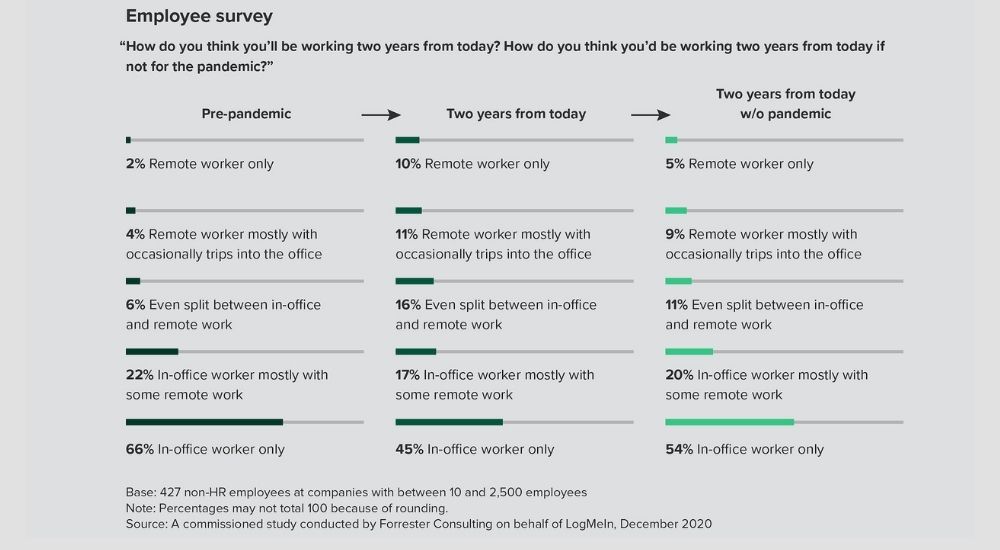
Anywhere work programmes are difficult; organisations should make sure they are strong in the key areas of remote work. Effective anywhere work programmes take real work and investment from organisations. They are not something that happens overnight. Organisations should focus on Forrester’s four pillars of remote work: structure, culture, technology, and compliance.
Remote work is essential to business success. Organisations that succeed in remote work see massive benefits to employees and the business. Workers at organisations with strong flexible work programmes are more productive and engaged, they produce better work, and they are more likely to stay at their company. More effective employees bring benefits to the bottom line.
Companies with mature remote-work programmes see improvements to their revenue, customer experience, and productivity along with a reduction in costs.
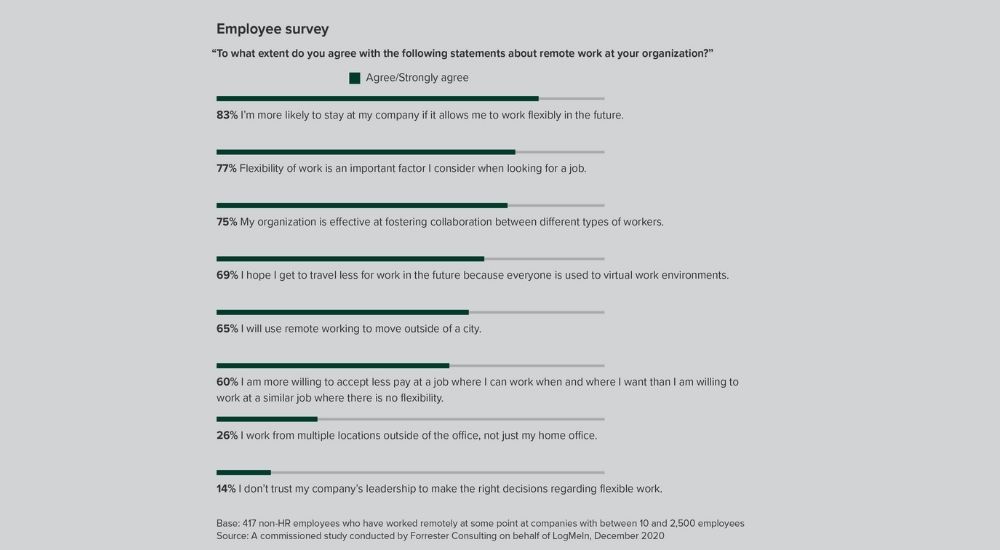
The pandemic sent many employees around the world into full-time remote work. Yet the trend toward remote work well-predates the pandemic, and it will remain long after. This presents major opportunities for companies to embrace the change and put in the effort to successfully manage the transition to remote work.
In surveying 582 remote-work decision-makers and 427 employees, the survey found various trends.
Remote and hybrid work are here to stay. The pandemic clearly created a sudden and massive shift to a remote workforce. While there will certainly be many workers who return to an in-office workstyle when the pandemic is over, there will also likely be permanent shifts in how people continue to work. In reality, the pandemic has simply accelerated a shift toward remote work that was already underway; the number of workers in the survey working mostly or exclusively in-office is shrinking from 88% of workers pre-pandemic to an anticipated 62% two years from now.
However, only 74% said they expect to be working in-office two years from now, even if the pandemic had not happened.
Flexible work can drive talent acquisition, diversity, and retention. The pandemic moved workers out of the office, and it is unlikely things will ever go back to the way they were before. Nearly three-quarters of surveyed employees said the pandemic made them want to work remotely more often in the future.
Less than half of the workers 48% said their ideal work arrangement would be mostly or exclusively in-office work. This is unsurprising, as 62% of employees said they are happier when working remotely.
If employers want to attract and retain the best and most diverse talent, it is key to offer flexible work programmes. 83% of employees said they are more likely to stay at their company if they are allowed to work flexibly in the future, and 77% said flexibility is an important factor they consider when looking for a job.
Antiquated perceptions cause a disconnect. Although employees are fairly clear regarding their interest in flexible work going forward, organisations still have some hesitancy. There is a perception that remote workers are less productive and less trustworthy.
While 56% of employees said they are more productive when working remotely and just 22% said they are more productive in-office, only 5% of remote-work decision-makers said they believe remote workers are more productive than their in-office counterparts, and 70% said in-office workers are more trustworthy.
Organisations need to double down on an anywhere work strategy. Employees in our survey were fairly enthusiastic about how their organisations handled the move to remote work during the pandemic. 74% said they are satisfied with the transition, and 70% said they are satisfied with their organisation’s handling of remote work overall.
Those who had never actually worked remotely before the pandemic are considerably more optimistic about their organisation’s ability to facilitate things like a home-technology environment or collaboration between remote workers. This indicates that this enthusiasm may have a shelf life as employees settle in to more permanent flexible-work arrangements.
While many employees may allow for a bit of a grace period to adjust to a new way of working, it’s important to recognise that decision-makers should start preparing for a less forgiving remote workforce in the future, and they should immediately create policies that will set up their organisations for success in the new normal.
Role of culture
Even with all of the correct tools in place, remote work cannot succeed without the right organisational culture. The way that companies think about flexible work initiatives and how employees work remotely is foundational to success. Forrester found the following trends.
There are issues around trust. There is a significant disconnect in trust between employees and employers when it comes to remote work, especially when it comes to productivity when working remotely. Organisations need to break through this outdated way of thinking and instead inject a foundation of trust.
To start, organisations should focus on working with managers to effectively cope with the mix of in-house and remote workers, overcome the stigma about remote workers, hire the right people, and offer specialised training about managing remote workers.
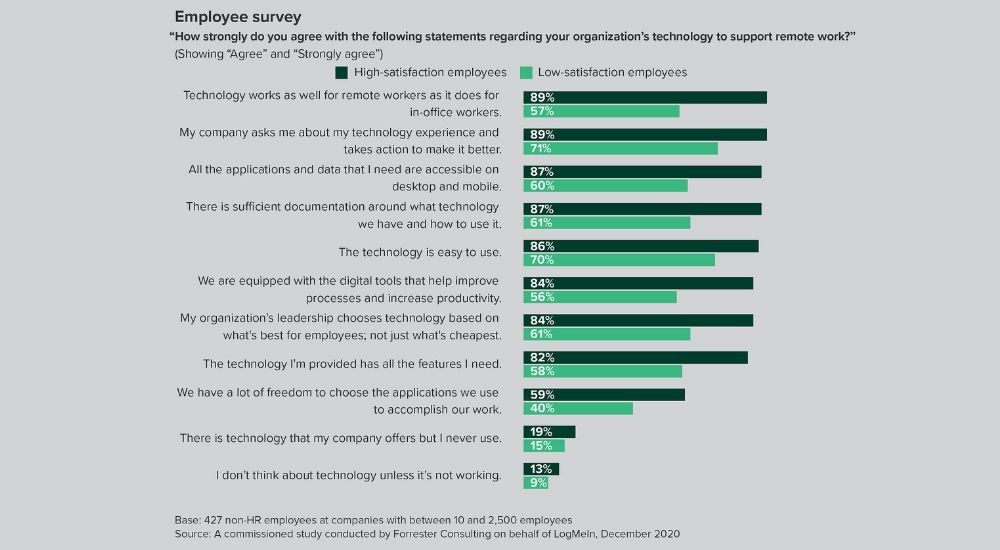
Organisations that prioritise employee engagement and happiness over cost set the foundation for a good culture. Surveyed remote-work decision-makers said their top priority for flexible work during the next year is reducing costs. But many decision-makers still think of flexible work as a cost-cutting measure in response to a shaky economic climate.
Businesses use remote work to justify real-estate cuts, to lower salaries for employees who are moving to less expensive parts of the country, or to hire new employees from areas with lower salary requirements.
However, this is an extremely shortsighted decision. Thinking of remote work as just a cost-cutting measure is ignoring the significant competitive differentiator that organisations can derive from having effective flexible-work plans. Additionally, employees notice cost-cutting.
Those with high remote-work satisfaction are considerably less likely to think their employers prioritise reducing costs when defining flexible-work policies, and they are far more likely to think their employers prioritise employee happiness.
Role of technology
As is the case with many parts of the business, flexible work can only be as successful as the technology supporting it allows. When analysing technology challenges around remote work, Forrester found the following trends.
Technology is key in driving anywhere work satisfaction. When it comes to flexible work, technology is as important as anything to drive employee satisfaction. High-satisfaction employees are far more likely to be at organisations that are doing the right things when it comes to technology.
This includes asking employees about their technology experiences and taking actions to make them better, providing sufficient documentation, and providing tech that is easy to use and works as well for remote workers as it does for in-office workers.
However, many organisations are falling short of these goals. When asked about their current technology suites, only 49% of respondents said their organisation is currently seeing key benefits.
However, when asked what key benefits they would expect to see from a strong and flexible work-technology suite, 80% of IT remote-work decision-makers said they expect a significant or transformational improvement in employee satisfaction.
Communication and collaboration tools are particularly important to driving employee satisfaction. Satisfaction with team messaging and voice over internet protocol VoIP are the most highly correlated with remote-work satisfaction. However, this an area that is very much in need of improvement.
The vast majority of surveyed employees rated their ability to communicate and collaborate with colleagues, partners, and customers to be higher when working in-office than when working remotely. Issues around communication can lead to challenges with building relationships and strong bonds between remote and in-office workers. Three quarters of surveyed decision-makers agree with this.
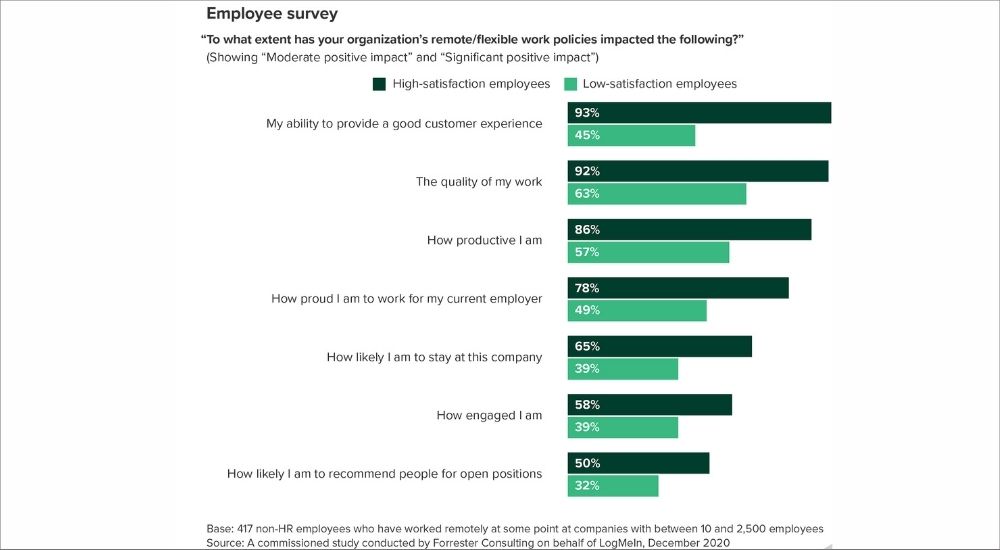
Organisations rushed to purchase technologies, but they need to consider the long-term consequences. Many technology issues that organisations are seeing today may stem from the way the organisations purchased them. Overall, decision-makers said 51% of the remote-work tools their organisations use today were purchased in response to the pandemic. The organisations faced a sudden and unprecedented number of remote workers to support, and decision-makers needed to adapt extremely quickly.
However, many of these technology decisions may not have been the best long-term choices, and they may cause problems down the road. In addition to the motivation for technology decision-making, the way these decisions are split between HR and IT is often flawed.
82% of surveyed decision-makers said the ideal way to make purchase decisions is with fairly even input from IT and HR. However, only 51% said their organisation actually makes decisions that way today.
Key recommendations
The world will never go back to the way it was, and remote work is here to stay. Get ahead of the curve and embrace anywhere work to differentiate your company from the competition. It will lead to higher levels of employee productivity, satisfaction, and engagement, and that will deliver higher retention, better CX, and more revenue.
But you cannot reap the benefits of anywhere work with a so-so commitment to it. You must invest in it head-on to ensure that employees can be successful each and every day at work.
Having a holistic technology experience is paramount. Even the best employee put in a remote-work situation will fail if they do not have the right technology to help them accomplish their work. But they need more than just Internet and laptops to be successful. Their technology experience must be just as good as it would be in an office — if not better.
That means organisations need to invest more in the anywhere-work experience by providing additional cloud-based tools. Firms that invest in these tools are more likely to drive employee engagement and to capitalise on the anywhere-work opportunity.
Forrester’s survey data revealed that IT decision-makers find it more difficult to support remote workers, but that is because they often do not have the right technology in place to ensure employees have a great experience.
Consider investing in extra tools such as remote PC access, cloud-based device management, self-service chatbots, and password managers to help IT decision-makers troubleshoot issues and automate the most mundane tasks that prevent them from focusing on improving the employee experience.
Ensure managers have what they need to manage effectively. Anywhere work requires a change to how leaders manage their direct reports. In a world where employees work unseen, the traditional top-down directive style of management no longer suffices. Instead, leaders must act as servant leaders and coaches, aiding to unblock barriers to employee productivity.
Having C-level executives work in a hybrid work configuration can help sell the idea of anywhere working and build confidence in middle management to develop skills to manage a remote workforce.
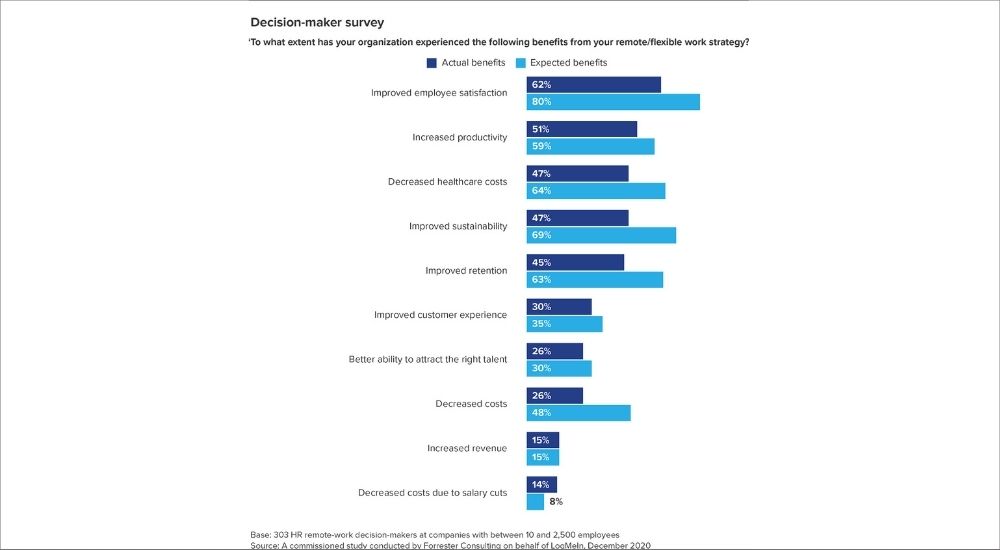
Rethink your office space. 37% of respondents said they are actively reducing office space as a result of a more permanent shift to remote work. The way we utilise the office is going to change in the future. Instead of having dedicated desks, organisations will move to hot-desking scenarios with a rotating workforce that works partially in the office and partially at home.
The office will increasingly be used for team-building and collaboration experiences. As you downsize office space, envision the most optimal way to use rooms to facilitate collaboration, learning, and design activities.
Embrace a Zero Trust strategy to secure your anywhere workforce. Fundamentally, Zero Trust is about protecting data wherever it resides and never trusting a network to provide adequate security. While most organisations are far away from using a true Zero Trust model, it is essential for companies that want to ensure maximum flexibility to work from anywhere.
Key takeaways
- While employees will return to previous in-office work settings post-pandemic, a rapid movement toward flexible work has begun.
- 26% of the workforce plans to shift from pure in-office work to a remote or hybrid work style within the next two years.
- Nearly three-quarters of workers said that pandemic made them want to work more remotely in the future.
- 62% of employees said they are happier when working remotely.
- There is a disconnect in trust between HR and employees.
- 56% of employees said they are more productive when working remotely.
- 61% said they can get more done in an 8-hour workday.
- Only 5% of remote-work decision-makers said they think remote workers are more productive.
- 70% of remote-work decision-makers, said in-office workers are more trustworthy.
Anywhere work programmes require investment and are not something that happens overnight, while organisations should focus on Forrester’s four pillars. Excerpted from Build an Anywhere Work Strategy to Drive Business Success by Forrester Consulting, commissioned by LogMeIn, March 2021.


